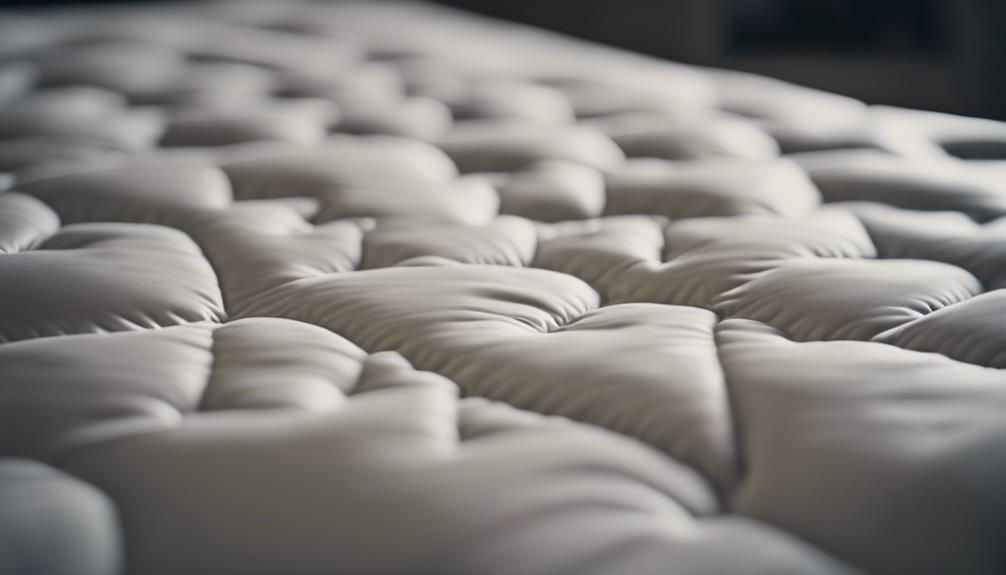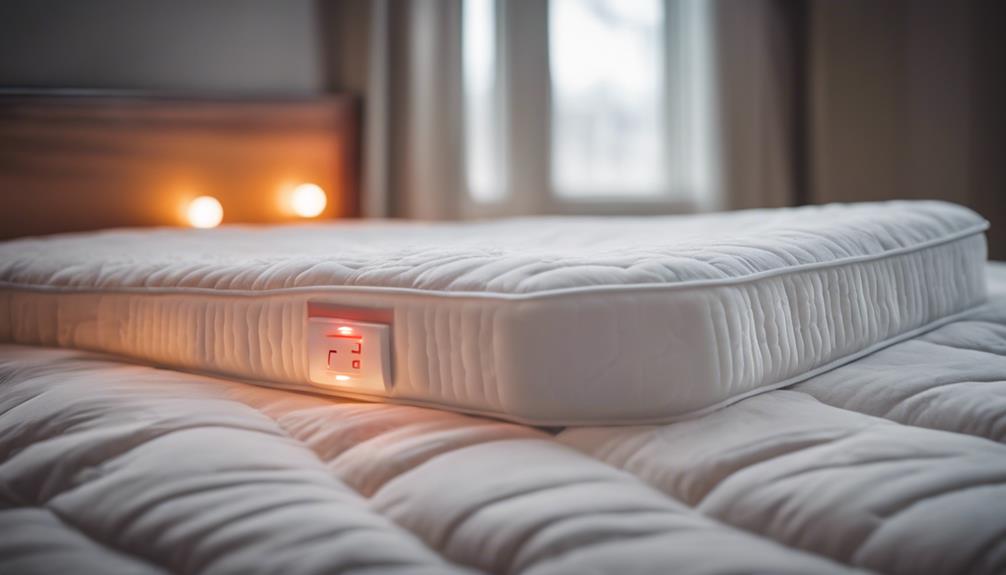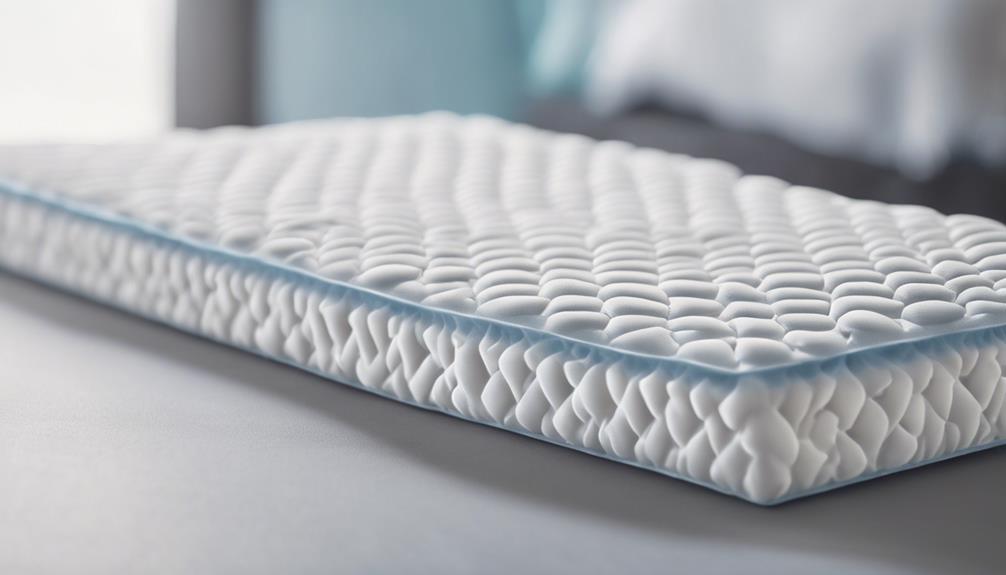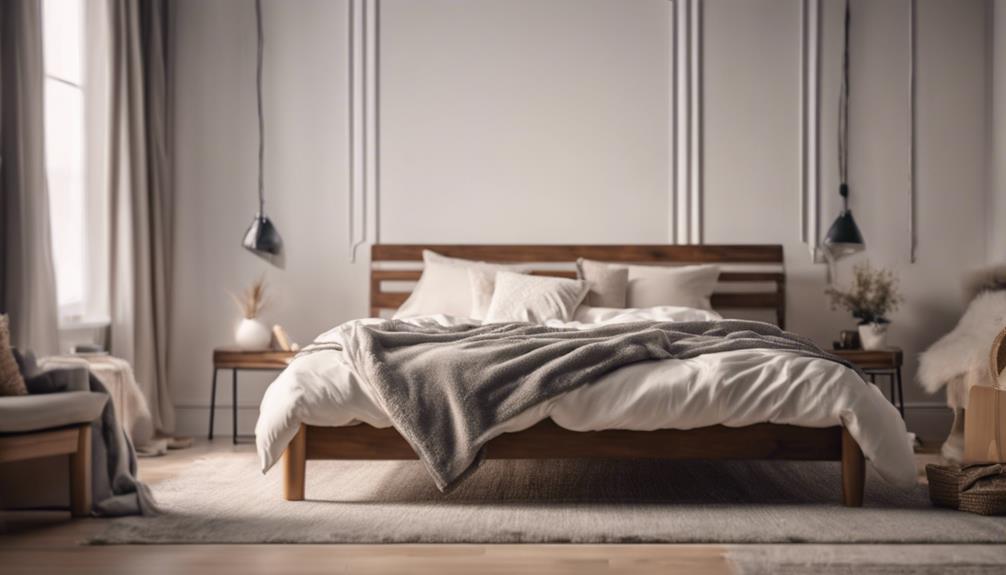Yes, mattress pads do wear out over time. Factors such as material quality, care habits, and usage frequency influence their lifespan, typically lasting 1 to 2 years. Signs like thinning fabric or decreased comfort indicate a need for replacement. To extend longevity, rotate pads regularly, follow care instructions, and consider using a mattress protector. Proper washing with mild detergents and occasional flipping can help maintain shape and support. Monitoring for persistent stains, odors, and comfort issues promotes better sleep quality. Be mindful of these indicators for a refreshed sleep surface.
Key Takeaways
- Average lifespan of 1 to 2 years, influenced by material quality and care.
- Signs of wear like thinning fabric indicate replacement is needed.
- Material quality and washing frequency impact longevity.
- Proper care, mild detergents, and following instructions enhance durability.
- Rotating, flipping, and regular cleaning extend the lifespan.
Average Lifespan of Mattress Pads
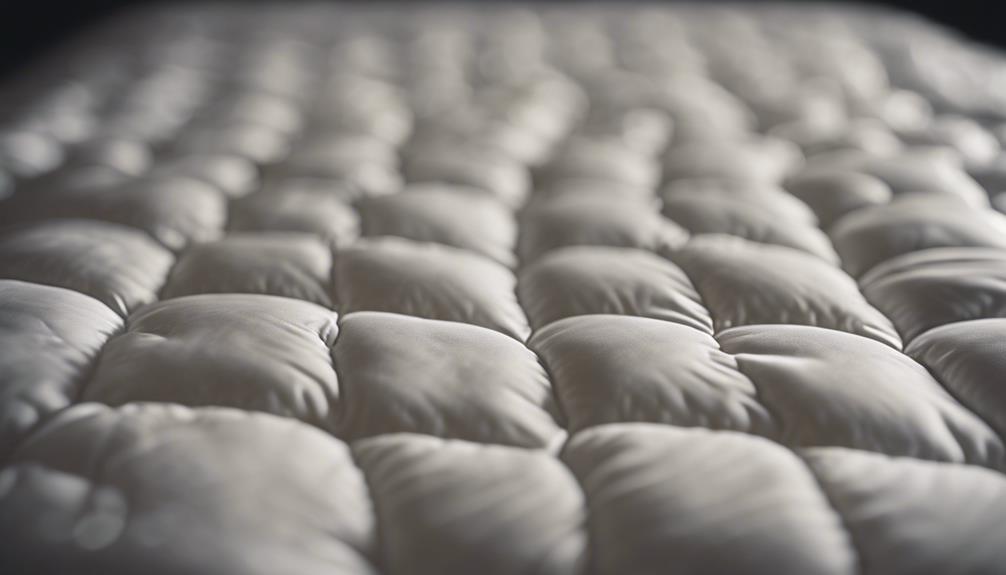
Mattress pads typically last an average of 1 to 2 years, with factors such as material quality and care affecting their longevity. The lifespan of mattress pads can vary based on the frequency of use.
Pads used daily will wear out faster compared to those used occasionally for guests or seasonal changes. Quality materials like memory foam tend to have a longer lifespan than basic polyester pads due to their durability and resilience.
Proper care, such as regular washing and following care instructions, can greatly extend the lifespan of a mattress pad. Noticing signs of wear, such as thinning fabric, stains, or decreased comfort, is essential as they indicate the need for replacement.
Factors Contributing to Mattress Pad Wear
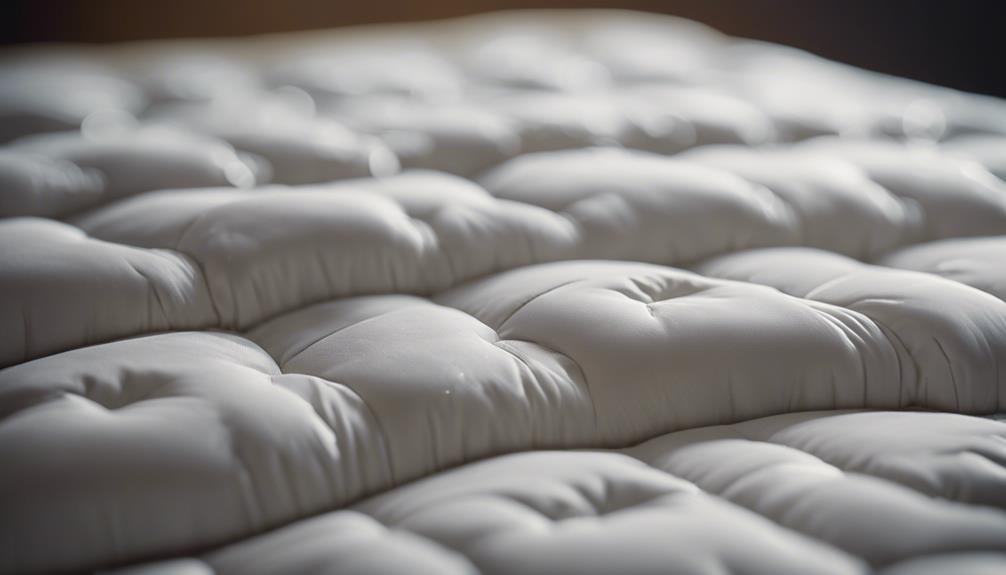
When it comes to the factors that contribute to mattress pad wear, the quality of materials used and how often we use them are key players.
The type of fabric and the frequency of washing play roles in how quickly a pad deteriorates.
We should also consider environmental factors like pets, food spillage, and perspiration, all of which can impact the longevity of our mattress pads.
Material Quality
Choosing a mattress pad made from top-quality materials greatly influences its durability and wear resistance. High-quality materials like memory foam or latex can greatly extend the lifespan of a mattress pad. Factors such as durability, resilience, thickness, density, and construction quality all play an important role in determining how long a mattress pad will last. Inferior materials may wear out quicker, leading to a shorter lifespan for the pad. By opting for a pad made from premium materials, you can guarantee a more durable and long-lasting product. Here's a table to help you understand how material quality impacts mattress pad wear:
| Material Quality | Impact on Wear Resistance |
|---|---|
| High-quality materials (e.g., memory foam, latex) | Longer lifespan |
| Durability and resilience | Better withstand daily use |
| Thickness and density | Affect longevity of the pad |
| Construction quality | Influences durability |
Frequency of Use
Considering the impact of frequency of use on mattress pad wear, the regularity of usage directly influences the longevity and durability of the pad. High-frequency use, like daily sleeping or intense activities on the bed, accelerates the wear and tear, leading to quicker deterioration of the pad's material and structure.
Conversely, infrequent use or placing the pad on secondary beds may result in less wear, ultimately extending its lifespan. To gauge the longevity of a mattress pad, it's essential to analyze usage patterns and adjust expectations accordingly.
Understanding how often and under what circumstances the pad is used provides valuable insights into its expected durability. By recognizing the effects of frequency of use, one can make informed decisions to maintain the pad's quality over time.
Impact of Washing on Mattress Pads
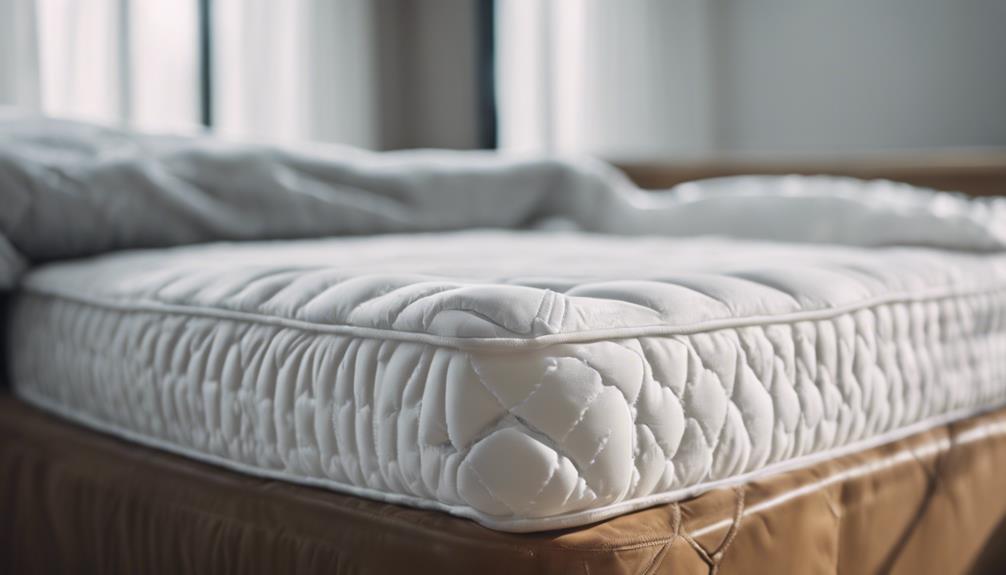
Frequent washing of mattress pads can accelerate wear and tear on the fabric and padding, leading to reduced longevity and effectiveness. Overwashing can result in premature fabric thinning and loss of padding, diminishing the overall quality of the pad. To maintain the lifespan of your mattress pad, it's important to follow the manufacturer's care instructions for washing.
Utilizing gentle cycles, mild detergents, and appropriate drying techniques can help minimize the negative impact of washing on the pad. Proper care during washing, such as avoiding high heat settings and harsh chemicals, is essential for extending the longevity of mattress pads.
Signs of Worn-Out Mattress Pads
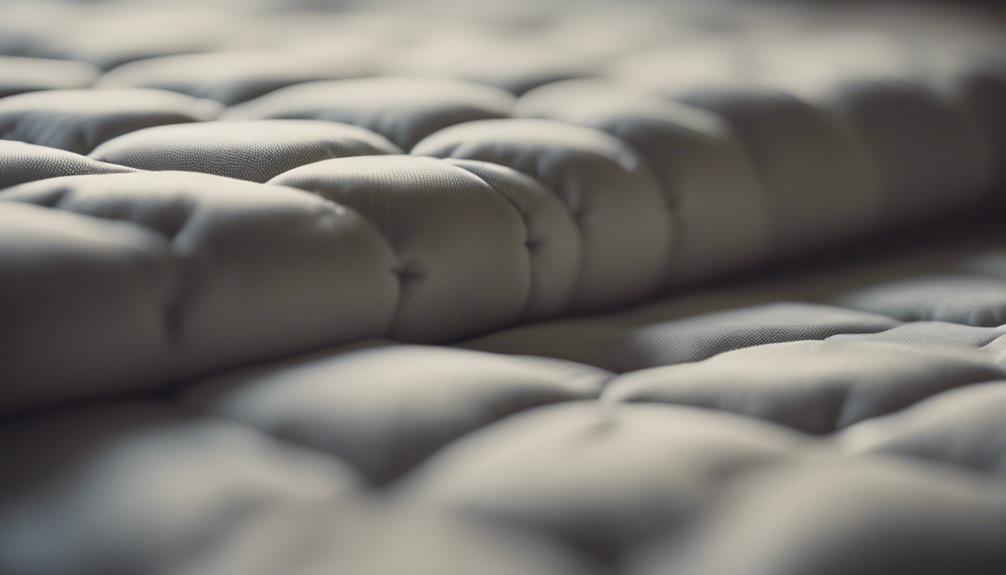
Thinning fabric, holes, or frayed edges serve as clear indicators that a mattress pad has reached the end of its lifespan. When these signs start appearing, it's time to contemplate a replacement.
Not only do these issues affect the appearance of the mattress pad, but they can also impact its comfort and support levels. A worn-out mattress pad may no longer provide the cushioning and protection your mattress needs.
Additionally, persistent stains and odors that refuse to budge even after washing are signals that it's time for a new mattress pad. These stains and odors can harbor allergens, affecting both your health and the quality of your sleep.
If you find yourself tossing and turning more at night or waking up with aches and pains, your mattress pad might be the culprit. Being attentive to these signs of a worn-out mattress pad ensures you can maintain a comfortable and supportive sleep environment.
Maintaining Mattress Pads for Longevity
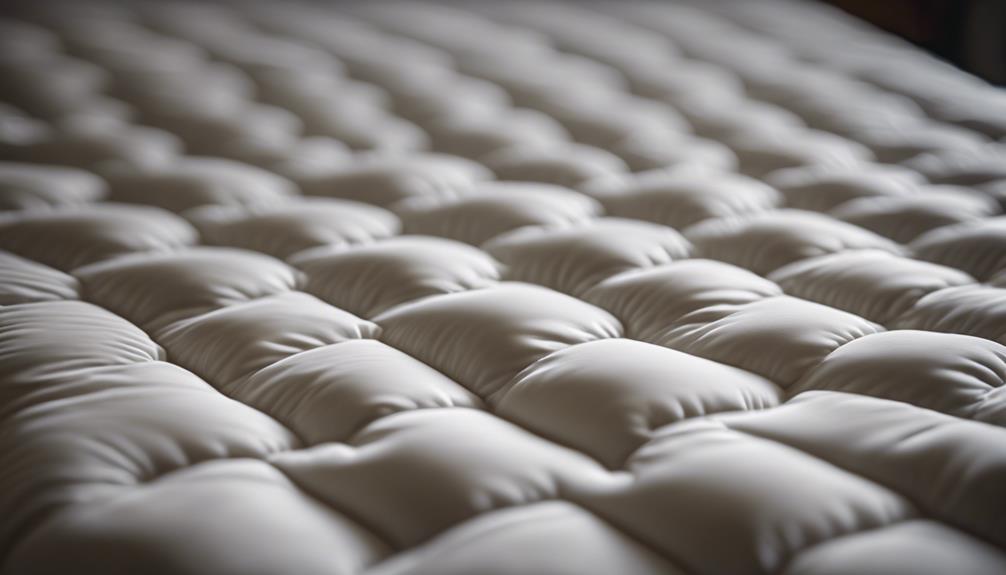
Let's talk about how to keep your mattress pad in top shape for longer use.
Regularly washing it according to the manufacturer's instructions can help maintain its freshness and extend its lifespan.
Additionally, flipping and rotating the pad can guarantee even wear, prolonging its durability.
Washing for Freshness
Regularly washing your mattress pad every 1-3 months is essential for maintaining its freshness and longevity. Following care instructions is vital to extend the pad's lifespan and promote proper hygiene.
Dirt, sweat, and allergens can accumulate over time, affecting the pad's condition and your sleep quality. By washing your mattress pad regularly, you can remove these contaminants, preventing premature deterioration and creating a cleaner sleep environment.
Freshly washed mattress pads contribute to better sleep comfort, making your bed a cozy sanctuary. Remember, proper cleaning not only keeps your mattress pad fresh but also helps you enjoy a healthier and more hygienic sleeping experience.
Flipping for Evenness
How can flipping and rotating your mattress pad regularly help maintain its longevity and comfort?
Regularly flipping and rotating your mattress pad is crucial to distribute wear evenly, preventing premature deterioration and extending its lifespan.
By flipping the pad every few months, you can help maintain its shape and support.
Additionally, rotating the pad ensures that all areas receive equal pressure, reducing the risk of lumps or sagging.
Consistent flipping and rotating not only help extend the pad's lifespan but also maintain a fresh feel, ultimately improving sleep quality.
Making these simple adjustments to your mattress pad maintenance routine can go a long way in securing its durability and enhancing your overall sleep experience.
Benefits of Using a Mattress Protector
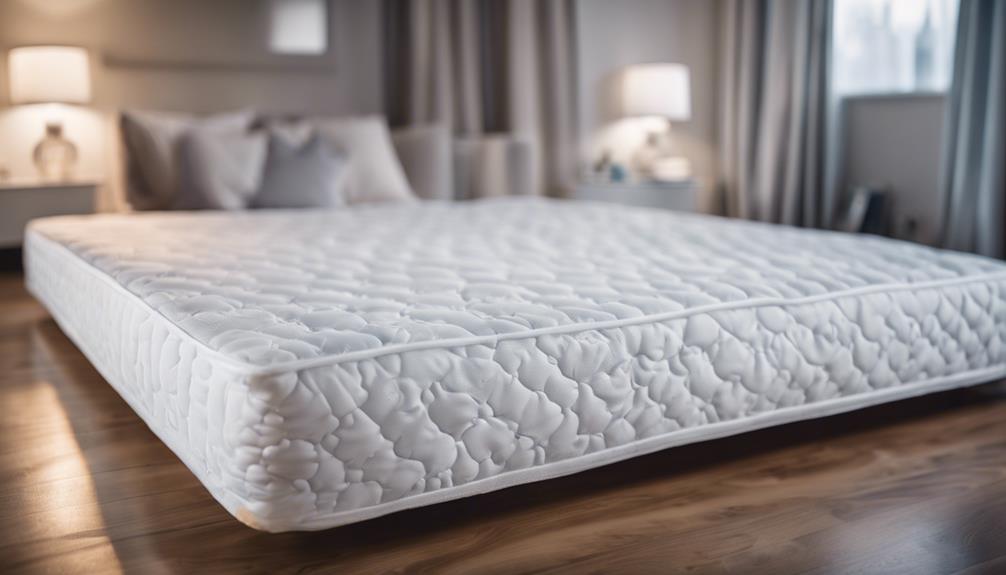
Using a mattress protector provides numerous benefits for maintaining the cleanliness and longevity of your mattress. A mattress protector acts as a shield, helping to prevent stains, spills, and damage that can occur over time.
By creating a barrier against dust mites, allergens, and even bed bugs, it guarantees a cleaner sleeping environment for you and your family. Additionally, using a mattress protector can extend the lifespan of your mattress by reducing wear and tear caused by everyday use.
For added protection, waterproof mattress protectors are available to guard against liquid spills and accidents, ultimately preserving the integrity of your mattress. Some mattress protectors even come with temperature-regulating features, offering a cool and comfortable sleep experience.
The benefits of using a mattress protector go beyond just protection; they contribute to a healthier and more durable mattress, ensuring a good night's sleep for years to come.
Rotating Mattress Pads for Durability
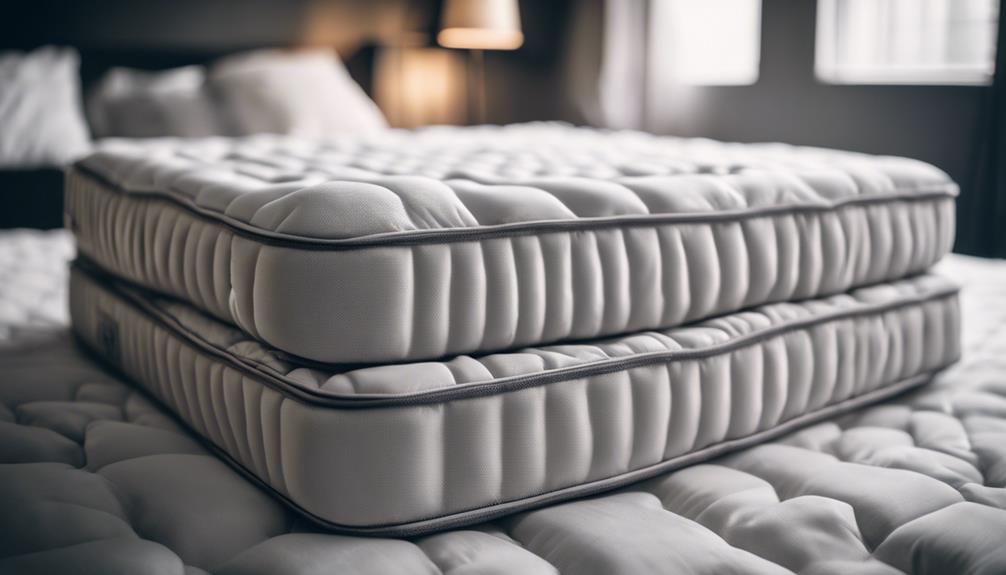
To maintain the durability of mattress pads, it's important to regularly rotate them to evenly distribute wear and tear. By rotating the mattress pad every 3-6 months, you can prevent permanent indentations from forming in specific areas. This simple practice can greatly extend the lifespan of your mattress pad and help maintain its comfort level over time.
When you rotate your mattress pad, you guarantee that the wear and tear is distributed evenly across its surface. This prevents certain areas from experiencing more pressure than others, which can lead to premature deterioration. Regularly flipping and rotating the pad will help it maintain its shape, support, and overall quality.
Extending Mattress Pad Lifespan
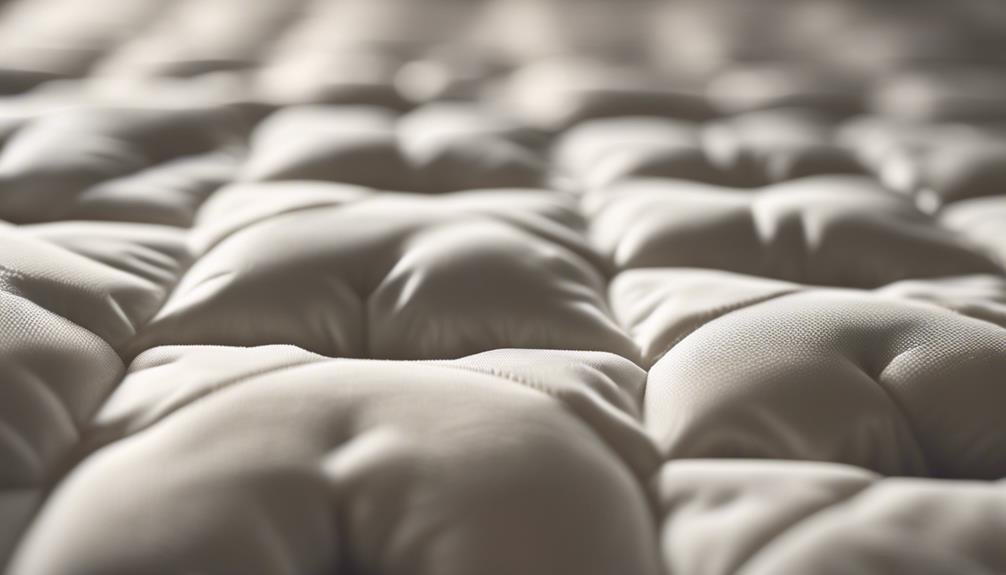
Regularly rotating and flipping your mattress pad is vital for ensuring its longevity and maintaining peak comfort. By following the manufacturer's care instructions, you can extend the lifespan of your mattress pad. Proper care, such as washing and drying according to guidelines, is essential in preventing premature deterioration. Incorporating these maintenance practices not only helps in extending the lifespan of the mattress pad but also guarantees excellent comfort for a longer period.
Using a mattress protector can shield the pad from spills, stains, and wear, further enhancing its durability. Rotating and flipping the mattress pad regularly promotes even weight distribution, reducing wear and tear over time. Regular cleaning and care play a significant role in preventing deterioration and maximizing the lifespan of your mattress pad. By adopting these simple yet effective measures, you can enjoy a comfortable and long-lasting mattress pad experience.
How to Clean Mattress Pads Effectively
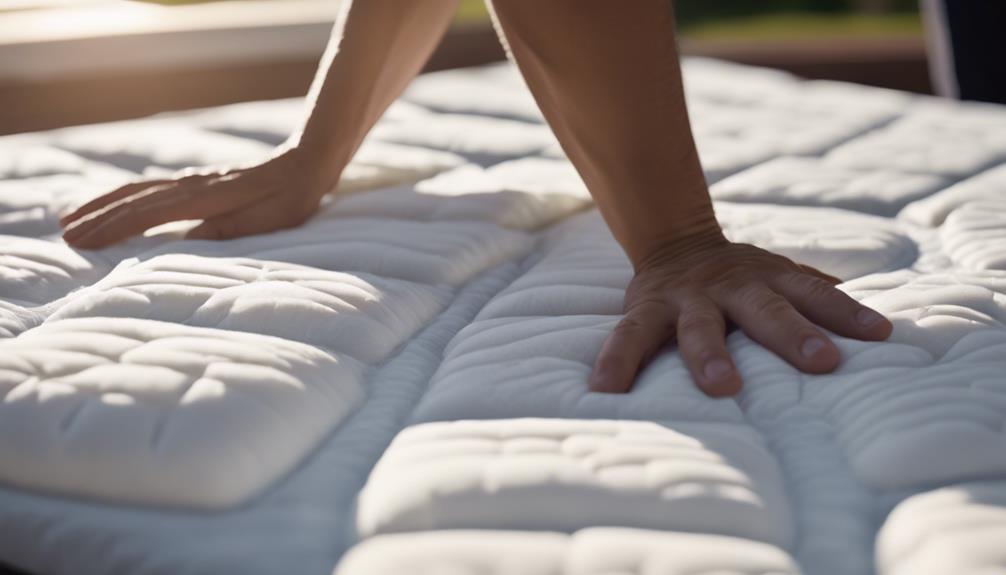
In maintaining the freshness and hygiene of your mattress pad, it's recommended to clean it every 3 months. To clean your mattress pad effectively, follow these steps:
- Check Washing Instructions: Always follow the manufacturer's instructions to guarantee compatibility with your washing machine and avoid damaging the pad.
- Use Gentle Cycles: For machine-washable pads, opt for gentle cycles to prevent wear and tear.
- Air Dry or Tumble Dry: After washing, either air dry the pad or tumble dry it on low heat to maintain its quality.
- Spot Clean with Mild Detergent: If your pad isn't machine washable, spot clean it using a damp cloth and a mild detergent.
- Regular Cleaning for Longer Lifespan: By cleaning your mattress pad regularly, you can prevent premature wear and extend its lifespan.
When to Replace Your Mattress Pad
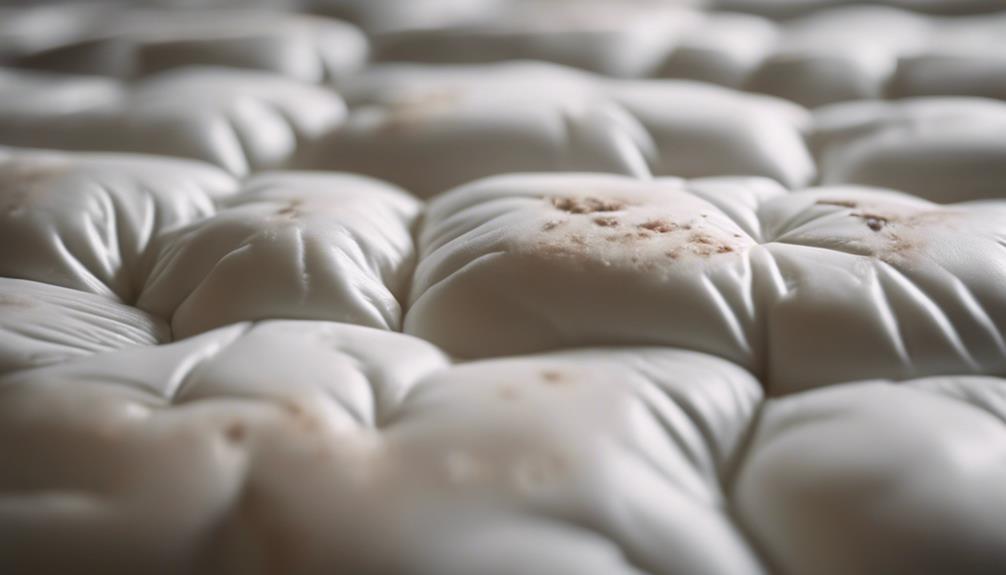
When considering when to replace your mattress pad, it's important to pay attention to signs of wear like thinning fabric, persistent stains, or decreased comfort levels.
Not only does changing the pad regularly enhance hygiene concerns, but it also guarantees a better night's sleep by preventing allergens and maintaining a clean sleep environment.
Monitoring for these signs and replacing the mattress pad in a timely manner can greatly improve your overall sleep quality.
Signs of Wear
Our mattress pad may need replacing if we notice thinning fabric, holes, or frayed edges compromising its protective function. Here are some signs that indicate it's time to replace your old mattress pad:
- Persistent stains and odors that resist washing out
- Accumulation of allergens impacting sleep environment
- Decreased comfort and support over time
- Maintenance of a clean sleep environment
- Improved overall sleep quality
Regularly changing your mattress pad not only guarantees a hygienic sleep environment but also helps in reducing allergens and enhancing your sleep quality. By being attentive to these signs of wear, you can maintain a comfortable and healthy sleep space.
Hygiene Concerns
Regularly checking the condition of your mattress pad guarantees a clean and healthy sleep environment. When stains, odors, or allergen accumulation become persistent, it's time to replace your mattress pad. Thinning fabric, holes, or frayed edges compromise the pad's hygiene and performance. These signs indicate that your mattress pad is no longer providing the protection you need.
Comfort Deterioration
Inspecting for signs of wear on your mattress pad is essential to ensuring exceptional comfort and sleep quality. Over time, mattress pads wear out, leading to comfort deterioration that can affect your sleep. Look out for decreased cushioning, support, and comfort, as well as body impressions, lumps, or sagging.
These are clear indicators that it's time to replace your mattress pad to avoid body aches, stiffness, and poor sleep. By regularly changing your mattress pad, you can refresh your sleep surface and enhance overall comfort for a rejuvenating night's rest.
Frequently Asked Questions
How Often Should You Replace a Mattress Pad?
When it comes to replacing a mattress pad, it's important to take into account factors like usage, material quality, and care practices.
Typically, experts recommend swapping out your mattress pad every 1-2 years for best performance. However, this timeframe can vary based on individual circumstances.
Signs that it may be time for a change include thinning fabric, persistent stains, odors, and decreased comfort.
Regularly updating your mattress pad helps maintain a clean sleep environment and enhances your overall sleep quality.
How Long Should a Mattress Pad Last?
Mattress pads typically last 2-3 years with regular use, but higher quality ones can endure up to 5 years. Factors like usage frequency, maintenance, and material quality affect longevity.
Signs of wear include thinning fabric, loss of support, and decreased comfort. Rotating and flipping the pad regularly can help distribute wear and extend its lifespan.
It's crucial to take into account these factors to maximize the longevity of your mattress pad.
What Is the Lifespan of a Mattress Protector?
The lifespan of a mattress protector typically ranges from 2 to 5 years. Factors like material quality and care impact longevity. High-quality protectors made of durable materials can last over 5 years.
Regular cleaning and proper maintenance can extend its life. Signs of wear include tears, leaks, stains that persist, and reduced effectiveness.
Following care instructions diligently can help maintain the protector's condition and protect your mattress for years.
Do Memory Foam Pads Wear Out?
Memory foam pads do wear out over time due to regular use and body weight. Signs of wear include loss of support, reduced comfort, and indentations in the foam.
The average lifespan is around 3-5 years, depending on usage. Factors like material quality, maintenance, and rotation frequency impact wear.
Using a mattress protector and regular cleaning can help extend the pad's lifespan. Proper care is key to maximizing durability.
Conclusion
To sum up, just like any other household item, mattress pads do wear out over time due to factors like usage and washing.
It's important to keep an eye out for signs of wear and tear, such as lumps or tears, to guarantee a comfortable and supportive sleep surface.
By rotating and cleaning your mattress pad regularly, you can extend its lifespan and enjoy a cozy night's rest for years to come.
Remember, a well-maintained mattress pad is the key to a good night's sleep.
